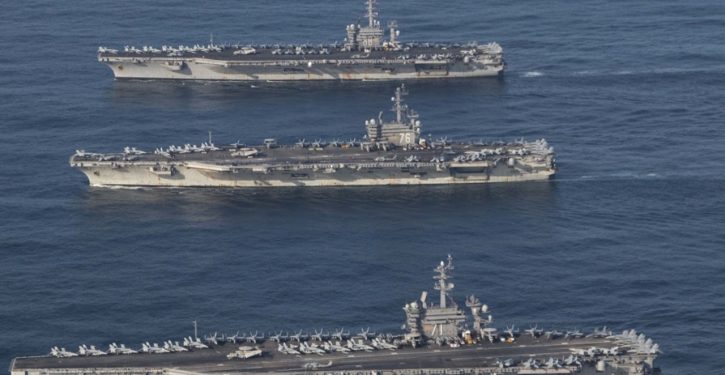
Blogger Jazz Shaw posted an article on Monday at Hot Air launching an opening volley in a debate over what China could achieve by trying to attack (and perhaps sink) a U.S. aircraft carrier. The hook was the veiled threat of a Chinese “admiral” (actually a defense-complex official of admiral-equivalent rank) that his navy might need to sink an American carrier or two to put us in our place.
Jazz Shaw doesn’t think much of the threat, and there’s good reason for that. It’s not a responsible military threat, of the kind a war-planner might make, if he were unleashed by his political bosses to make threats for some reason. As Shaw’s treatment notes, there would be game-changing consequences to China for taking an action so extreme. The Chinese would need a more measurable and serious objective than “putting America in her place” to justify incurring those consequences.
That’s what the whole question hinges on, in fact: what reason China would have to try to sink our carriers, and whether it would be worth it.
Will this presidential election be the most important in American history?
Feasibility
But in approaching the issue, we need to start by establishing whether China could sink our carriers. The answer is clearly yes, but it wouldn’t be easy, it wouldn’t depend principally on hitting a carrier with missiles (even hypersonic ones), and it wouldn’t actually be necessary – that is, to literally sink the carrier – to have an effect we couldn’t recover from quickly.
First of all, the Chinese could achieve an effect that would serve their purposes for all but the longest wartime slugfest by disabling a carrier’s propulsion systems. Without the ability to make 35 knots of wind over the flight deck, the carrier loses most of its utility. A carrier can’t be versatile and on-call if it has to wait for enough wind to naturally occur; it has to be able to make its own, by operating at sufficient speeds.
It takes that wind over the flight deck to recover fixed-wing manned aircraft: the workhorses that provide the vast majority of the combat services afforded by a carrier (maritime and land strike, counter-air fighter protection, electronic warfare, longer-range reconnaissance, refueling).
The carrier could still operate helicopters and UAVs, with limited propulsion, but it couldn’t participate usefully in its own defense, and would thus become a liability to the fleet rather than a net asset. The speed factor is also integral, obviously, to making the carrier a rapidly responsive, repositionable asset, one that can zoom at top revs on nuclear power to put 50 strike-fighters off a misbehaving coast within days or hours.
To disable a carrier to this level, send in submarines to torpedo it down by the keel, at a minimum messing up the screws and the screw shafts. The worse off these assemblies are, the less speed the carrier can make. And the long shafts on a carrier, if sufficiently damaged, are actually much harder to fix than holes in the flight deck or the tower.

In my estimation, this attack would be a multi-sub job for China’s quietest attack submarines – and quite possibly a suicide mission for at least one of them. A carrier has four screws attached to four massive shafts; for optimum, effectively permanent damage, at least three have to take major hits.
But antisubmarine warfare (ASW) is one of our chief vulnerabilities, across the spectrum of maritime operations, and China has the ability to exploit that. Our ships aren’t sitting ducks, by any means, but the carriers have some of the least self-defense capability of any of our ships against the submarine threat. The concern here is a real one.
When operationally deployed, the carriers are always attended by at least one cruiser or destroyer with a full suite of ASW tools, and supported by a ship-shore ASW surveillance and interdiction network. Airborne ASW support from land-based P-8 and P-3C aircraft and fleet helicopters is sophisticated and essential. Between them, these assets and the network they plug into can do a lot.

But in China’s back yard – i.e., the South China Sea, the southern islands of Japan – the U.S. carrier and its escort(s) are on a long tether. If tensions are especially high, more escorts are desirable. Even with more of them, it’s fully conceivable for China’s People’s Liberation Army Navy (PLAN) to overwhelm a carrier’s ASW defense envelope, and get inside it with enough juice to get the job done.
If China has some purpose for literally sinking the carrier, disabling its propulsion first would be any sensible targeteer’s choice. Leave the carrier unable to maneuver, and going at it with missiles (and more torpedoes) then becomes more feasible and productive. Cruise missiles with sophisticated homing capabilities would do more than the famous anti-carrier ballistic missile China has been developing, but if the carrier is largely immobilized, the ACBM might get its day in the sun as well.
The carrier has some formidable close-in defense weapons, but the ammo will run out at some point. To pummel the carrier at will, meanwhile, would require taking out the Aegis escort(s), at least by rendering them ineffective, if not necessarily sinking them. We’ll leave that for a moment, as it gets to the strategic purpose China has and the cost-benefit calculus for Beijing. It’s an escalation: taking on an attack scenario that requires neutralizing a whole set of targets and not just the main one.
But strictly in terms of the feasibility question, the PLAN, operating close to home, could bring the assets to bear to get this part of the job done.
Another option, by no means dismissible, would be for China to attack our carrier in port, or at anchor offshore from a port, using special forces. This would involve a whole separate set of factors, starting with the lead-time to develop a capability to operate covertly in this manner. If the Chinese wanted to lay explosive charges below the carrier’s waterline, for example, it would require long study of the port and our habits in it, and a determination of when such an attempt was least likely to be detected. It could well require cultivating in-port human assets as well. (Merely laying mines-in-waiting and hoping our carrier would drive into their threat envelope would serve other purposes, but not the purpose of ensuring a carrier was disabled or sunk.)
There are multiple potential scenarios to game out here; think up your own variables if you like planning challenges. Bottom line: it’s another option, and one China is adequate to.
Purpose
The purpose will ultimately govern the choices, however, since China in fact has choices. Perhaps the leadership in Beijing would sign off on an anti-carrier attack that was mainly meant to be ostentatiously attributed to China – and thus prove a point. I tend to doubt that, but if we took it as an assumption, then we might see the PLAN throw the kitchen sink at a carrier, sending in submarines to die until they nailed the carrier at the keel and then raining down missiles and torpedoes on the carrier and any U.S. Navy ship trying to fend off the assault.
This would be such a huge waste of expensive naval assets, I am hard-put to imagine fleet commanders being willing to execute it, or political leaders really pushing for it.
It’s more likely that disabling one or more U.S. carriers would be a means of shaping the battlespace conditions for a larger and more rational objective (rationality here not meaning “morally acceptable,” but rather “logical for a strategic goal,” however politically objectionable the goal might be).
If China wanted to make a massed, rapid move to seize Taiwan, for example, and at the same time effectively occupy and/or control all the islands and reefs in the South China Sea, while neutralizing any response from the other claimants, that goal might justify something as big as disabling all the U.S. carriers in the Far East. (That number would be at least one, and potentially up to three.)
In such a case, the Chinese probably wouldn’t be anxious to clarify for us what was going on. The more they could achieve by stealth, surprise, and confusion, the better.
They would also have the operational constraint of wanting to conserve assets. They’d do as much as necessary to neutralize U.S. weapon systems, long enough to establish a new reality, one from which they could only be dislodged by a big fight. They wouldn’t do more than that. Decisively disabling a carrier would be more likely than the much larger effort to guarantee that it sank.
Moreover, the U.S. wouldn’t be the only force in the mix. Japan would inevitably react in some way – with military force – and the reactions of Australia, Indonesia, Vietnam, and Thailand, at the very least, would figure into Beijing’s calculations. Taking out a U.S. carrier, or more than one, would be intended to impress and daunt those other nations as well as to hobble the United States.
But that doesn’t mean China would therefore seek to advertise how or by whom it was done. Stealth and uncertainty might actually be of more use in shaping regional fears and expectations (and perhaps exploiting deniability; i.e., in China’s relations with Russia, which would have to remain stable. Russia would have no illusions about who did what, but could be easier to handle if China weren’t making Moscow’s political position unnecessarily difficult).
U.S. response – and why its consequences are not a given
As Jazz Shaw says, the likelihood of a strong American response is high. All things being equal, we do have the technology to do what he outlines in his article:
[I]f the Chinese actually did decide to open fire on one of our carriers, they might succeed in a surprise attack. But we would be able to decimate all of the useful and powerful elements of their navy in short order. We could also put quite a pounding to Beijing if we were so inclined. And by sinking one of our ships, the Chinese would have committed an act of war anyway so there would be nothing stopping us. Short of going to tactical weapons and given the massive logistical hurdles involved in shipping any significant number of their soldiers anywhere near our mainland, we could probably handle them.
But all things aren’t equal today. Shaw mentions shortfalls in readiness and logistics, and those are important. Another concern is China’s defense capability against air and missile attack, which is formidable even under “equal” conditions. It might be short work to make it safe enough for the aging but powerful B-52 to operate over Iran, but there’s no guarantee the Stratofortress could operate over China at all, at least not in the combat phase of greatest operational utility. Even the B-2 and the F-22 would be vulnerable. Missiles from our Global Strike arsenal aren’t guaranteed to get through. The fight to use our technology would be much bigger than we’re used to.
But there’s another concern that doesn’t get the airtime it deserves, and that’s the effort China has been putting for nearly 30 years into cutting-edge electronic and information warfare. Our strike technology is heavily dependent on the “C4ISR” – command, control, communications, computers, intelligence, surveillance, reconnaissance – that China has been working hard on being able to interdict.
We need satellite links. They’re not just nice to have; they’re indispensable. Being without them is a no-go condition, not just for standoff precision strike, but for strike, period. Beyond strike (i.e., attacking targets, whether kinetically or in other ways), satellite links are indispensable for coordinating an extended battlespace and operating with sight and understanding in all its tactical dimensions, instead of blind.
And China has the capability to neutralize or degrade satellite links – deny them to us for localized purposes, even if they aren’t lost altogether. How good China is at this is something we won’t know for sure until China does it in a live operation. But it can’t be overemphasized that this is a condition of operations we don’t have a ready fallback from, and it is integral to the prowess we are justly famous for. Blinding us in the C4ISR realm is a way to set us back for a decisive period of time, if an enemy can manage it.
China has also been developing capabilities to interfere with the functioning of our weapon systems on-scene; e.g., at the point of tactical engagement, such as when aircraft are approaching a warship, or anti-air missile systems are reacting to attack sorties, or fighters are approaching a bomber and its escorts. Since the end of the Cold War, we have not broadly resourced our military to actually fight an enemy with the sophisticated capabilities China would display. Our combat experience has been mostly against 1960s-era weapon systems operated by Iraq and Serbia.
Dealing with China will not be that easily-overestimated, quiescent proposition. And there is yet another dimension to the electronic warfare problem versus China, which is that we’ve spent years buying IT parts from China and putting them in some of our military systems.
We don’t know the extent to which China might be able to activate malware “sleepers” in the case of a military fight with us, but we cannot reasonably assume there’s zero probability of it.
As a final point, moreover, China has the ability to hold our homeland territory at risk, not just with ballistic missiles but with the threat of electronic disruption and other forms of anti-population warfare (e.g., attacking our public utility systems). The old Cold War risk equation of “Chicago for Berlin” is in play again, if in a different form now. A quixotic attempt to land Chinese troops in Long Beach isn’t the only way for China to annoy and preoccupy us in our homeland fastness.
China’s calculus
None of the bad news above means that China will be cavalier about provoking a confrontation with the United States. That has never been China’s M.O., and we can expect the more likely pattern of circumspection and long-term preparation to hold true. China likes to induce prizes to fall into her hands, by increments and by other methods, rather than making a career of military blitzkrieg. By the time a Chinese blitzkrieg is in the offing, maneuvering for a more effective defense against it may even be futile – if China has her way.
That said, it’s not a good idea to be complacent about our capabilities vis-à-vis the operational scenario we’d be likely to face with China. Our capabilities are very good, and we do a lot of important things better than anyone else. But China has the will-and-momentum advantage of being the dissatisfied power in this picture: the one that isn’t happy with the status quo, and wants among other things to imperially control the South China Sea and subjugate Taiwan. It’s China, not the U.S., that will be giving priority to military preparation and planning.
We have other things to think about, and we need to be frank with ourselves: those other things have caused us to give less priority than we should to understanding how well or poorly our technology will get the job done, if we have to slug it out with China in the Eastern hemisphere. The question here isn’t ultimately whether China would sink our carrier, or try to. It’s what China’s strategic goals are, as Xi marches along consolidating power and repressing internal dissent, and what meaning the U.S. carrier has in the context of those goals. That is what will decide, for China, what China can afford.




